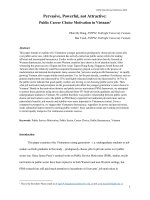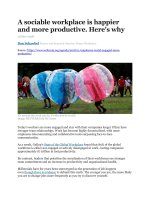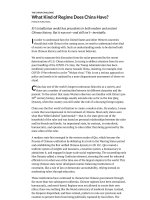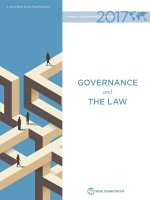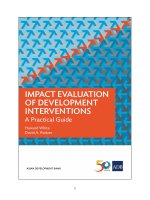Bài đọc 1.1. What Makes a Nation Rich? One Economist's Big Answer (Chỉ có bản tiếng Anh)
Bạn đang xem bản rút gọn của tài liệu. Xem và tải ngay bản đầy đủ của tài liệu tại đây (81.63 KB, 3 trang )
<span class='text_page_counter'>(1)</span><div class='page_container' data-page=1>
<b>World Poverty Map</b>
Network Osaka
/>
<b>What Makes a Nation Rich? One Economist's Big Answer</b>
Say you're a world leader and you want your country's economy to prosper. According
to this Clark Medal winner from MIT, there's a simple solution: start with free elections.
<b>By Daron Acemoglu</b>
<b>We are the rich, the</b>
haves, the developed.
And most of the rest —
in Africa, South Asia,
and South America, the
Somalias and Bolivias
and Bangladeshes of
the world — are the
nots. It's always been
this way, a globe
divided by wealth and
poverty, health and
sickness, food and
famine, though the
extent of inequality
across nations today is
unprecedented: The
average citizen of the
United States is ten times as prosperous as the average Guatemalan, more than twenty times as
prosperous as the average North Korean, and more than forty times as prosperous as those
living in Mali, Ethiopia, Congo, or Sierra Leone.
The question social scientists have unsuccessfully wrestled with for centuries is, Why? But the
question they should have been asking is, How? Because inequality is not predetermined. Nations
are not like children — they are not born rich or poor. Their governments make them that way.
<b>You can chart the search for a theory of inequality to the French political philosopher</b>
Montesquieu, who in the mid-eighteenth century came up with a very simple explanation: People
in hot places are inherently lazy. Other no less sweeping explanations soon followed: Could it be
that Max Weber's Protestant work ethic is the true driver of economic success? Or perhaps the
richest countries are those that were former British colonies? Or maybe it's as simple as tracing
which nations have the largest populations of European descent? The problem with all of these
theories is that while they superficially fit some specific cases, others radically disprove them.
It's the same with the theories put forth today. Economist Jeffrey Sachs, director of Columbia
University's Earth Institute, attributes the relative success of nations to geography and weather:
In the poorest parts of the world, he argues, nutrient-starved tropical soil makes agriculture a
challenge, and tropical climates foment disease, particularly malaria. Perhaps if we were to fix
these problems, teach the citizens of these nations better farming techniques, eliminate malaria,
11/4/2010 Print - What Makes a Nation Rich? One…
</div>
<span class='text_page_counter'>(2)</span><div class='page_container' data-page=2>
or at the very least equip them with artemisinin to fight this deadly disease, we could eliminate
poverty. Or better yet, perhaps we just move these people and abandon their inhospitable land
altogether.
Jared Diamond, the famous ecologist and best-selling author, has a different theory: The origin of
world inequality stems from the historical endowment of plant and animal species and the
advancement of technology. In Diamond's telling, the cultures that first learned to plant crops
were the first to learn how to use a plow, and thus were first to adopt other technologies, the
engine of every successful economy. Perhaps then the solution to world inequality rests in
technology — wiring the developing world with Internet and cell phones.
And yet while Sachs and Diamond offer good insight into certain aspects of poverty, they share
something in common with Montesquieu and others who followed: They ignore incentives. People
need incentives to invest and prosper; they need to know that if they work hard, they can make
money and actually keep that money. And the key to ensuring those incentives is sound
institutions — the rule of law and security and a governing system that offers opportunities to
achieve and innovate. That's what determines the haves from the have-nots — not geography or
weather or technology or disease or ethnicity.
Put simply: Fix incentives and you will fix poverty. And if you wish to fix institutions, you have to fix
governments.
<b>How do we know that institutions are so central to the wealth and poverty of nations? Start in</b>
Nogales, a city cut in half by the Mexican-American border fence. There is no difference in
geography between the two halves of Nogales. The weather is the same. The winds are the
same, as are the soils. The types of diseases prevalent in the area given its geography and
climate are the same, as is the ethnic, cultural, and linguistic background of the residents. By
logic, both sides of the city should be identical economically.
And yet they are far from the same.
On one side of the border fence, in Santa Cruz County, Arizona, the median household income is
$30,000. A few feet away, it's $10,000. On one side, most of the teenagers are in public high
school, and the majority of the adults are high school graduates. On the other side, few of the
residents have gone to high school, let alone college. Those in Arizona enjoy relatively good
health and Medicare for those over sixty-five, not to mention an efficient road network, electricity,
telephone service, and a dependable sewage and public-health system. None of those things are
a given across the border. There, the roads are bad, the infant-mortality rate high, electricity and
phone service expensive and spotty.
The key difference is that those on the north side of the border enjoy law and order and
dependable government services — they can go about their daily activities and jobs without fear
for their life or safety or property rights. On the other side, the inhabitants have institutions that
perpetuate crime, graft, and insecurity.
Nogales may be the most obvious example, but it's far from the only one. Take Singapore, a
once-impoverished tropical island that became the richest nation in Asia after British colonialists
enshrined property rights and encouraged trade. Or China, where decades of stagnation and
famine were reversed only after Deng Xiaoping began introducing private-property rights in
agriculture, and later in industry. Or Botswana, whose economy has flourished over the past forty
years while the rest of Africa has withered, thanks to strong tribal institutions and farsighted
nation building by its early elected leaders.
Now look at the economic and political failures. You can begin in Sierra Leone, where a lack of
11/4/2010 Print - What Makes a Nation Rich? One…
</div>
<span class='text_page_counter'>(3)</span><div class='page_container' data-page=3>
functioning institutions and an overabundance of diamonds have fueled decades of civil war and
strife and corruption that continue unchecked today. Or take communist North Korea, a
geographical, ethnic, and cultural mirror of its capitalist neighbor to the south, yet ten times
poorer. Or Egypt, cradle of one of the world's great civilizations yet stagnant economically ever
since its colonization by the Ottomans and then the Europeans, only made worse by its
post-independence governments, which have restricted all economic activities and markets. In fact, the
theory can be used to shed light on the patterns of inequality for much of the world.
<b>If we know why nations are poor, the resulting question is what can we do to help them. Our</b>
ability to impose institutions from the outside is limited, as the recent U. S. experiences in
Afghanistan and Iraq demonstrate. But we are not helpless, and in many instances, there is a lot
to be done. Even the most repressed citizens of the world will stand up to tyrants when given the
opportunity. We saw this recently in Iran and a few years ago in Ukraine during the Orange
Revolution.
The U. S. must not take a passive role in encouraging these types of movements. Our foreign
policy should encourage them by punishing repressive regimes through trade embargoes and
diplomacy. The days of supporting dictators because they bolster America's short-term
foreign-policy goals, like our implicit support of Muhammad Zia-ul-Haq in Pakistan starting in the 1970s,
and our illicit deals with Mobutu's kleptocratic regime in the Congo from 1965 to 1997, must end.
Because the long-term consequences — entire nations of impoverished citizens, malnourished
and hungry children, restive, discontented youngsters ripe to be drawn toward terrorism — are
too costly. Today that means pushing countries such as Pakistan, Georgia, Saudi Arabia, Nigeria,
and countless others in Africa toward greater transparency, more openness, and greater
democracy, regardless of whether they are our short-term allies in the war on terror.
At the microlevel, we can help foreign citizens by educating them and arming them with the
modern tools of activism, most notably the Internet, and perhaps even encryption technology and
cell-phone platforms that can evade firewalls and censorship put in place by repressive
governments, such as those in China or Iran, that fear the power of information.
There's no doubt that erasing global inequality, which has been with us for millennia and has
expanded to unprecedented levels over the past century and a half, won't be easy. But by
accepting the role of failed governments and institutions in causing poverty, we have a fighting
chance of reversing it.
<i>Acemoglu is currently writing a book about his theory of inequality with James Robinson, a Harvard</i>
<i>government professor, from which this essay was adapted.</i>
